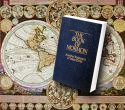
FAIR is a non-profit organization dedicated to providing well-documented answers to criticisms of the doctrine, practice, and history of The Church of Jesus Christ of Latter-day Saints.
mNo edit summary |
mNo edit summary |
||
| Line 30: | Line 30: | ||
| valign="top"|Artifacts||Body, arrow ||Human bones, a skeleton, arrow||Human bones||Human bones, arrow||Human bones, arrow||Skeleton of man, arrow | | valign="top"|Artifacts||Body, arrow ||Human bones, a skeleton, arrow||Human bones||Human bones, arrow||Human bones, arrow||Skeleton of man, arrow | ||
|- | |- | ||
| valign="top"|Person?|| Zalph, large thick-set man,<br> warrior, killed in battle ||Zalph, warrior, killed in battle||GAS||Zalph, warrior, white Lamanite|| | | valign="top"|Person?|| Zalph, large thick-set man,<br> warrior, killed in battle ||Zalph, warrior, killed in battle||GAS||Zalph, warrior, white Lamanite||Mighty prophet, killed in battle||Zalph, warrior, white Lamanite,<br>man of God, killed in battle | ||
|- | |- | ||
| valign="top"|Nephite/<br>Lamanite?|| | | valign="top"|Nephite/<br>Lamanite?|| Nephite and Lamanite ||Lamanite||--||Lamanite||--||Lamanite | ||
|- | |- | ||
| valign="top"|JS Vision?|| | | valign="top"|JS Vision?|| Vision: Onandangus, great prophet<br>Known Atlantic to Rockies ||--||--||Onandangus||--||Onandangus, <br>Known Atlantic to Rockies | ||
|- | |- | ||
|} | |} | ||
William Hamblin described some of the difficulties with this story: | William Hamblin described some of the difficulties with this story: | ||
| Line 43: | Line 42: | ||
:many significant qualifiers were left out of the printed version [of this account]. Thus, whereas Wilford Woodruff's journal account mentions that the ruins and bones were "probably [related to] the Nephites and Lamanites," the printed version left out the "probably," and implied that it was a certainty. [There are] several similar shifts in meaning from the original manuscripts to the printed version. "The mere 'arrow' of the three earliest accounts became an 'Indian Arrow' (as in Kimball), and finally a 'Lamanitish Arrow.' The phrase 'known from the Atlantic to the Rocky Mountain,' as in the McBride diary, became 'known from the Hill Cumorah' (stricken out) or 'eastern sea to the Rocky Mountains.' " The point here is that there are many difficulties that make it nearly impossible for us to know exactly what Joseph Smith said in 1834 as he reflected on the ruins his group encountered in Illinois.{{ref|hamblin1}} | :many significant qualifiers were left out of the printed version [of this account]. Thus, whereas Wilford Woodruff's journal account mentions that the ruins and bones were "probably [related to] the Nephites and Lamanites," the printed version left out the "probably," and implied that it was a certainty. [There are] several similar shifts in meaning from the original manuscripts to the printed version. "The mere 'arrow' of the three earliest accounts became an 'Indian Arrow' (as in Kimball), and finally a 'Lamanitish Arrow.' The phrase 'known from the Atlantic to the Rocky Mountain,' as in the McBride diary, became 'known from the Hill Cumorah' (stricken out) or 'eastern sea to the Rocky Mountains.' " The point here is that there are many difficulties that make it nearly impossible for us to know exactly what Joseph Smith said in 1834 as he reflected on the ruins his group encountered in Illinois.{{ref|hamblin1}} | ||
LDS scholars have differed about the reliability of the accounts, and their relevance for Book of Mormon geography.{{ref|procon1}} | |||
==Endnotes== | ==Endnotes== | ||
| Answers portal |
| Book of Mormon Geography |

|
|
Geography: DNA: Archaeology: Lamanites in North America: Other: |
This page is based on an answer to a question submitted to the FAIR web site, or a frequently asked question.
This article is a draft. FairMormon editors are currently editing it. We welcome your suggestions on improving the content.
Joseph Smith reportedly found the bones of an individual named "Zelph," during the Zion's camp march. Does this have implications for Book of Mormon geography?
The most common version of this story is found in the History of the Church.[1] It should be noted, however, that the History of the Church version was created by amalgamating the journal entries of several people:
A comparison of the various accounts is instructive:[3]
| Aspect | WW | HCK | GAS | LH | MM | RM |
|---|---|---|---|---|---|---|
| Date | May-June 1834 | JS on 3 June 1834 | Group on 2 June 1834 | -- | -- | JS on 3 June 1834 |
| Place | Illinois River | Illinois River | -- | Illinois River | Pike County | -- |
| Description | -300 ft above river -Flung up by ancients |
-Several 100 feet above -3 altars on mound |
300 ft above river | Big mound | -many mounds -fortifications |
-- |
| Artifacts | Body, arrow | Human bones, a skeleton, arrow | Human bones | Human bones, arrow | Human bones, arrow | Skeleton of man, arrow |
| Person? | Zalph, large thick-set man, warrior, killed in battle |
Zalph, warrior, killed in battle | GAS | Zalph, warrior, white Lamanite | Mighty prophet, killed in battle | Zalph, warrior, white Lamanite, man of God, killed in battle |
| Nephite/ Lamanite? |
Nephite and Lamanite | Lamanite | -- | Lamanite | -- | Lamanite |
| JS Vision? | Vision: Onandangus, great prophet Known Atlantic to Rockies |
-- | -- | Onandangus | -- | Onandangus, Known Atlantic to Rockies |
William Hamblin described some of the difficulties with this story:
LDS scholars have differed about the reliability of the accounts, and their relevance for Book of Mormon geography.[5]

FAIR is a non-profit organization dedicated to providing well-documented answers to criticisms of the doctrine, practice, and history of The Church of Jesus Christ of Latter-day Saints.
We are a volunteer organization. We invite you to give back.
Donate Now